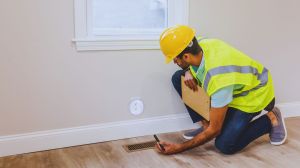Steps to Buying Your First Investment Property
Real estate investing is exciting and can be very profitable. To learn how to buy an investment property, you’ll need to identify your goals, find the right place to buy, run the numbers, and assemble a team. Let’s explore the opportunities of this dynamic investment sector one step at a time!
Step One: Identify Your Goals
Of course, your overall goal will be to earn a return on your investment, but there are a few different ways to accomplish this. For example, you might want a steady monthly income, or you may be focused on long-term value appreciation. The most common strategies are:
Buy and Hold
A common reason to buy investment property is to generate consistent income over a long period of time. Purchasing a property you can rent out accomplishes this goal. The key is to find a property you can rent steadily and with little additional investment on your part.
House Flipping
Many people buy an investment property to renovate and sell it as quickly as possible. This strategy can yield quick profits, and it can be thrilling. However, it comes with unique risks, including the potential for losses rather than profits.
Short-Term Rentals
If renting to the vacation and executive housing market is appealing to you, you can buy an investment property specifically for this purpose. With the right property in the right market, you can earn steady income and take advantage of property appreciation over time.
House Hacking
With house hacking, you buy an investment property with multiple living units and live in one while renting out the others to help with your mortgage. This gives you steady income with some landlord responsibilities while sparing you the hassles of managing a larger building.
Start your real estate investment journey by reflecting on why you want to buy an investment property. Each strategy has different risk levels, time commitments, and requires unique skills. Carefully consider which plan fits best with your financial goals, lifestyle, and level of experience.
Step Two: Assess Your Finances
Before you buy an investment property, figure out how much financing you could qualify for. If you’ve got cash on hand, you don’t need to worry, but if you need a mortgage, be prepared to meet stricter requirements than you would if you were buying a home.
Most lenders require at least 15% to 25% down when you buy an investment property, so you’ll need a substantial amount of cash. You might also need a higher credit score to qualify. Don’t overlook the additional expenses you’ll have when you buy investment property, including closing costs, inspection fees, and repairs you may need to make before you can rent the property out.
Step Three: Find the Best Place to Buy Investment Property
As with other types of real estate, location is key. But when you buy an investment property, location doesn’t only matter for lifestyle and resale reasons; it also matters because you’ll need renters.
When evaluating potential locations, look for markets that have:
- Solid job growth and economic stability.
- A growing population, driven either by jobs and industry or by immigration.
- High demand for rentals, as indicated by vacancy rates, increasing average rents, and high renter-to-owner ratios.
- Lower property taxes and landlord laws that are easy to understand and navigate.
- Less restrictive laws for short-term and vacation rentals.
- Solid appreciation potential, even if you plan to hold the property long-term.
Don’t restrict your search to popular coastal cities; take a look at emerging markets with strong fundamentals like stable industries. You can find great opportunities in the Midwest and the South, where your initial investment will likely be lower.
Step Four: Choose a Property Type
When you buy an investment property, the type should align with your investment goals. Each property type serves a different purpose.
Single Family Homes
A single-family home is easier to finance and manage. They also tend to appreciate reliably, and they attract longer-term tenants, which reduces your risk and the time you’ll need to put in to market and maintain the property. When they’re wondering “how do you buy an investment property,” many first-time investors choose to purchase a single-family home.
Multi-Family Properties
Although they are a bit more time-consuming to manage, multi-family properties such as duplexes, triplexes, or small apartment buildings give you multiple streams of income at the same time. If you don’t want to handle the day-to-day tasks involved, you can always hire a property manager to do most of it for you.
Condos and Townhouses
If you want to buy an investment property with low maintenance requirements, choose a condo or townhouse that has a homeowner’s association. Although HOA fees will cut into your profits, the HOA will take care of the home’s exterior and the common areas. Many of these properties also come with amenities that are attractive to potential renters.
Commercial Real Estate
The commercial real estate market offers numerous opportunities. If you want to buy an investment property to rent to a business, you can purchase anything from a small storefront to an entire plaza to a factory or warehouse. As a first-time investor, this may not be a comfortable or accessible option, but it’s something to keep in mind as you gain experience and confidence.
Step Five: Do the Math
A key element of how to buy an investment property successfully is to run the numbers. Don’t let the dream of passive income lull you into a false sense of confidence; it should come down to dollars and cents!
Here are some key metrics you’ll need to calculate:
Cash Flow
Your monthly rental income minus all your expenses, including mortgage payments, taxes, insurance, maintenance costs, property management fees, HOA fees and vacancy allowance. This tells you how much cash you’ll have coming in that’s not needed for expenses.
Net Operating Income (NOI)
Monthly income less expenses other than mortgage payments. This tells you how much a property earns from its operations regardless of how you finance it. This figure helps you compare options when you want to buy an investment property.
Cap Rate
Net Operating Income (NOI) divided by the price of the property. This helps you compare different properties you might be considering.
Cash-on-Cash Return
Annual cash flow divided by total cash invested (down payment and closing costs). This is a simple way to calculate whether the property is working for you, similar to checking the interest rate on a financial investment.
Learning how to buy an investment property means understanding the numbers and what they mean. Take the time to get on top of the essentials before jumping in, or consult with an expert who can calculate and interpret the figures for you.
Step Six: Build a Team
Most successful real estate investors work with a team of advisors, including:
- A real estate agent who specializes in investment properties in the area you’re interested in.
- A mortgage broker or lender experienced in investment property financing.
- A real estate attorney who can review your contracts and ensure you’re protected legally.
- A property manager, if you don’t intend to do the landlord-related tasks yourself.
- An accountant who understands real estate investing and can help you keep accurate records, do your income tax, and take advantage of tax breaks available to investors in your jurisdiction.
Assemble your team as soon as possible, preferably before you buy an investment property.
Step Seven: Find the Right Property, Make an Offer, and Close the Deal
The final step of how to buy an investment property is to make a purchase. Your real estate agent will help you put together a competitive offer and guide you through the rest of the process. Be sure to include an inspection contingency, as the condition of the property is a key part of determining whether the investment is a wise one.
Step Eight: Managing Your Property
Congratulations! You have learned how to buy an investment property, and you’ve done it successfully. But the work is just beginning for you. From now on, you’ll need to keep a careful eye on maintenance problems, vacancy rates, and tenant issues. Remember that hiring a property manager is always an option. The right one will take most of the work and worry off your plate so that you can focus on the numbers!









